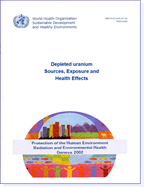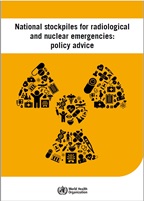
Depleted uranium
Depleted uranium (DU) is a by-product of the uranium enrichment process used in nuclear power plants and weapons production. It is a dense, heavy metal with unique properties that make it useful in military applications, such as armour-piercing ammunition and armour plating. DU has been used in medical and industrial applications for decades but since its use in military conflicts over the past few decades public concern been raised about potential health consequences from exposure to DU. Concerns have been particularly voiced regarding military personnel, humanitarian workers and local populations living and working in areas contaminated by DU following conflict. In response to these concerns, the scientific evidence on sources, exposure and health effects of DU was summarized in a WHO report in 2001, following research on the health consequences to veterans of Gulf and Balkan military conflicts. The WHO Regional Office for Europe also conducted a fact-finding mission to Kosovo and published a report in 2001.
More recently, the UNSCEAR’s 2018 Report (Annex D) addressed the effects of Uranium and its isotopes, including depleted uranium. Based on the available evidence and the limitations identified in the scientific robustness of the studies that were reviewed, it was concluded that there was no convincing evidence of an association between exposure to DU and clinical outcomes, including any type of cancer and congenital malformations.
The United Nations General Assembly (UN GA) has also addressed the issue, first in 2007 when it issued Resolution N62/30 on Effects of the use of armaments and ammunitions containing depleted uranium. It invited member states and relevant international organizations to report on their views on the effects of the use of DU containing armaments and ammunitions. Since then, the UN Secretary General’s office has been regularly reporting to the General Assembly, the latest being the 2022 UN GA Resolution N77/49.
Publications

This scientific review on depleted uranium is part of the WHO's ongoing process of assessment of possible health effects of exposure to chemical, physical...
Report of the World Health Organization Depleted Uranium Mission to Kosovo: 22 to 31 January 2001
The Director-General of the World Health Organization (WHO) received a request for assistance from the Special Representative of the Secretary-General...
World Health Assembly fifty-fourth session, provisional agenda item 13.10
WHO guidance on exposure to depleted uranium: for medical officers and programme administrators
These recommendations, produced but the World Health Organization in conjunction with the United Nations Joint Medical Service, are for medical officers...
More resources

This document describes protocols and practices for ensuring the essential elements of a national stockpile of medical countermeasures for radiation emergencies,...
This updated version of the compendium provides a systematic compilation of published guidance from WHO and other UN organizations on health and environment....
Guidelines for drinking-water quality: fourth edition incorporating the first and second addenda
The fourth edition incorporating the first and second addenda, of the World Health Organization’s (WHO) Guidelines for drinking-water quality (GDWQ)...
A guidance document for medical teams responding to health emergencies in armed conflicts and other insecure...
This publication, also referred to as the “Red Book”, offers a guidance framework and introduces additional verification requirements for...
Partners resources
